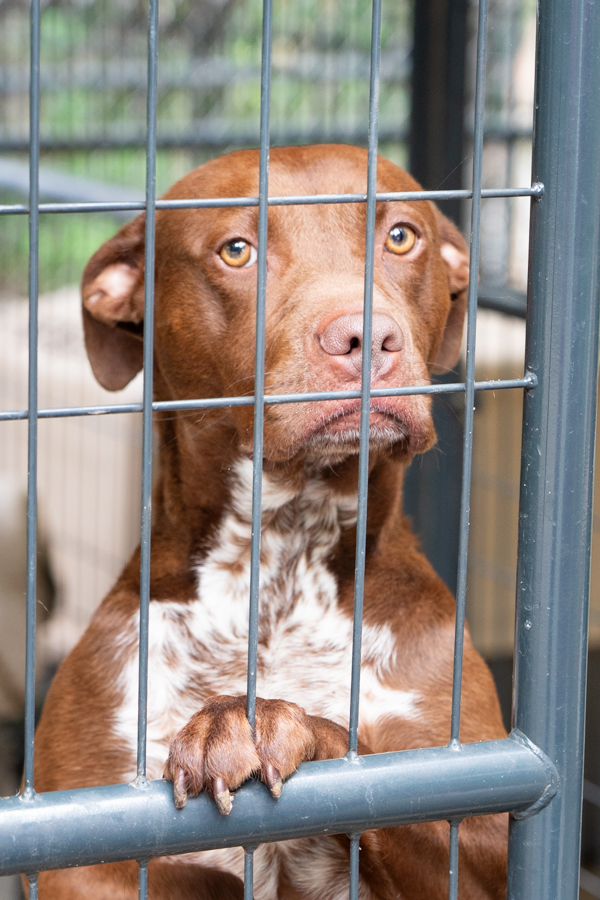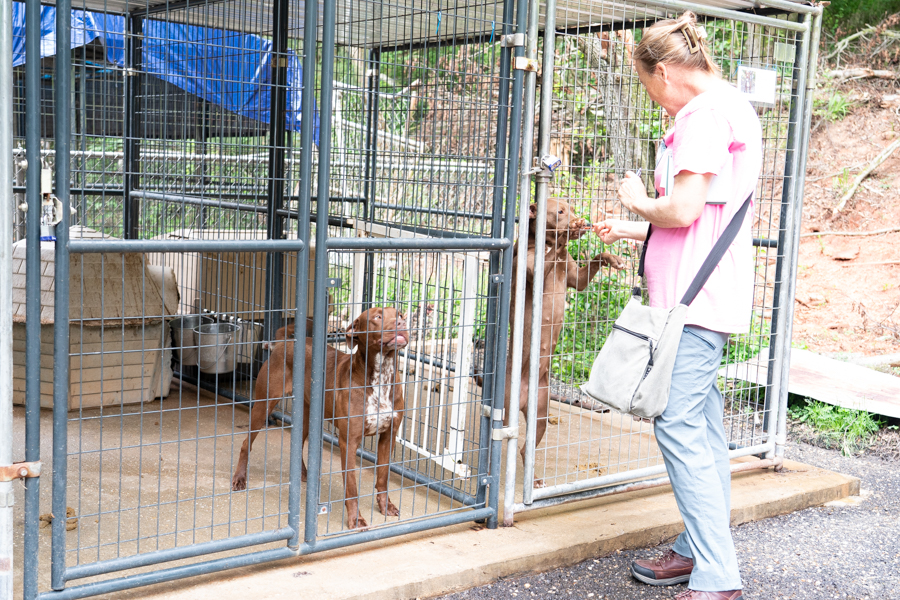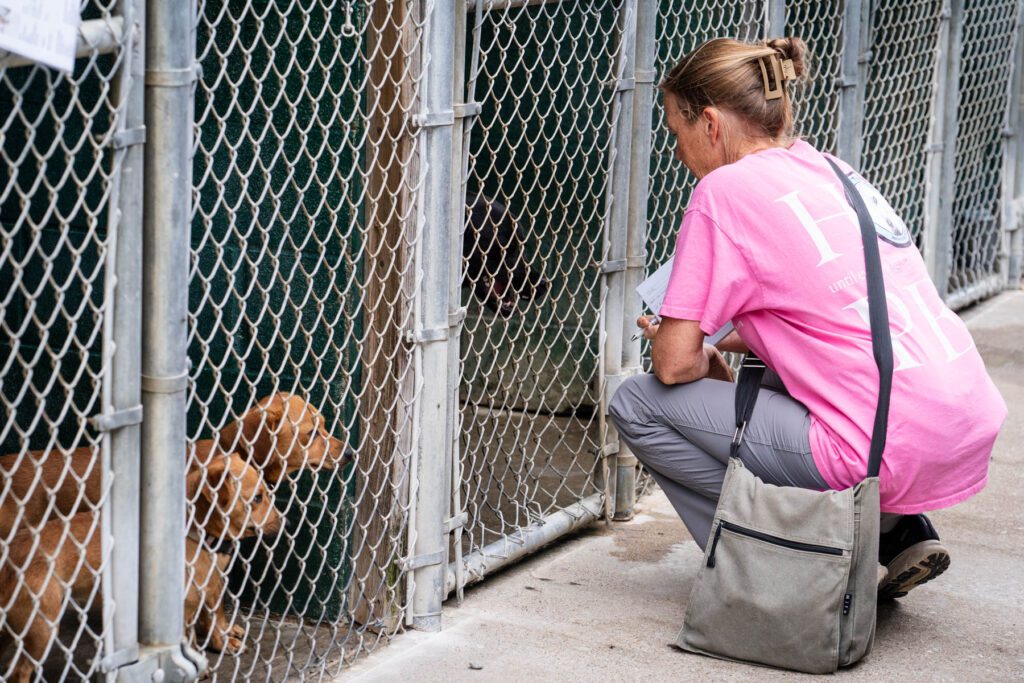We can’t save them all.

That’s what I’m telling myself as my heart is crushed knowing a dog I so wanted to save is being euthanized today. I’m getting a tiny taste of what so many shelter directors and ACOs experience on the regular.
The shelter where Mazy has lived for the last 18 months is, like so many others, overwhelmed. Until the end of 2023 they had been able to save every saveable dog thanks to rescue partners and the hard work and commitment of the staff (who make only the minimum wage in Alabama, including the director).
When we visited the shelter this past spring, the heartbreak of the situation was clear on the director’s face as she walked us through the crowded kennels. She looked stunned and sad, but also resigned to the situation. They were housing probably more than twice as many dogs as they should have been (almost all in outdoor kennels as their small building was full of puppies).






That increased intake (they are open intake for a city and county) combined with the loss of their rescue partners, left them in an impossible situation. With nearly no adoptions, very little support from the community and limited veterinary access (which will become zero tomorrow when the vet who has been helping them retires), they are left with impossible decisions.
“Three a week.”
That’s how many dogs the director must pick to be euthanized. Somehow Mazy had made the cut over and over again, despite being an energetic pit-bull type dog. Clearly, the director had a soft spot for her. Mazy was happy and friendly when we met her. A beautiful dog. She’d actually been pulled for rescue twice early in her stay at the shelter, but couldn’t handle being crated, and both times the transport van turned around and brought her back.

I told the director, I really hoped I could come back for Mazy, and I meant it. I came home already thinking about a return trip and spoke with two different rescues about accepting her as a transfer if I fostered. But then a mini-crisis erupted locally and my foster cottage filled with puppies and dogs from an eviction/backyard breeder situation. It took months to get them healthy and placed in homes.
And then just like so many of us, I got busy with my own life, my work, WWLDO, my family, and going back to Alabama to get Mazy slipped down the list. I’d get her in the fall on our next tour, I told myself.
And then on Friday, there she was on the red list for that week. I started scrambling to put a plan into action to go get her, but it was too late. After speaking with the director, I learned that since my visit, Mazy had popped positive for heartworm (attendants had not given the preventatives the shelter provides – six other dogs also tested positive). And with restricted opportunities to play with other dogs and get exercise (the play area is housing overflow dogs and Mazy is a fence climber), she had become unpredictable with other dogs.
So, now, even if I found the funds to treat her heartworm, I simply couldn’t house her in my foster cottage. If she can’t be crated, doesn’t get along with other dogs and will climb the fence of my play yard, I have no safe space for her.
Today, Mazy will die, along with two other dogs. And my tears make no difference. All I can do is re-commit to saving the ones I can save, and telling the stories of the ones I can’t.
I’ve spent this summer finishing up a book about the people and dogs I’ve met on nearly 150 shelter visits, sharing not just their stories, but the solutions I’ve seen work and solutions I believe will work. I’m tired of talking about the problem of so many dogs suffering and dying in the shelters. It’s time we focus on fixing this very fixable problem. Our country has tackled far more difficult challenges. The situation in our shelters is getting worse, not better. We have to do things differently. We have to try new solutions. We need to help, not just the dogs who are suffering, but the people who are working so very hard, sacrificing their hearts, to this fight.
Mazy will be heavy on my heart today, but even heavier will be the director who has to drive her to the vet and then come back to that overcrowded shelter, and work so hard to try to save the others. She should not be doing this alone.
You can be part of the solution—no matter where you live. Volunteer, foster, drive a transport, promote adoption, donate, support a struggling shelter, work for fair housing and insurance laws that don’t discriminate by breed. There are endless ways you can use your unique set of talents and treasure to make a difference.
If you want to find a shelter to help, visit our shelter partner page, where you can find links to the shelters we’ve visited. Start where you are and do something.
Don’t think one person can make a real difference? You need to know Linda Taylor, Laura Prechel, and Liz and Michelle at X-Port Paws. They are all women who decided to do something and then did.
If you already work or volunteer in a shelter, check out our free Resource Guide full of ideas, programs, resources, grants, and every fundraiser, event, or shelter practice we find. Check back regularly because we are always adding new stuff.
We can all do something. It’s time we did.

Until each one has a home,
Cara
If you want to learn more, be sure to subscribe to our email list to get the latest stories and solutions delivered to your inbox. And help us spread the word by sharing this post with others. Visit our website to learn more.
Our Annual Online Auction is coming up in September. Check out what we’ve got so far (and register to bid). If you’d like to donate an item, preferably something easy to ship (like gift cards, tickets and/or e-certificates) or something you will ship yourself, reach out. Contact Cara@wwldo.org.

You can also help raise awareness by following/commenting/sharing our content on Facebook, Instagram, YouTube, and Tik Tok.
To see our Emmy-nominated, award-winning short documentary, Amber’s Halfway Home, click here. If you’d like to see it on the big screen (along with other short dog films), check out the tour schedule of The Dog Film Festival, currently in art movie houses all over the country.
Learn more about what is happening in our southern shelters and rescues in the book, One Hundred Dogs & Counting: One Woman, Ten Thousand Miles, and a Journey Into the Heart of Shelters and Rescues (Pegasus Books, 2020). It’s the story of a challenging foster dog who inspired me to travel south to find out where all the dogs were coming from. It tells the story of how Who Will Let the Dogs Out began. Find it anywhere books are sold.
For more information on any of our projects, to talk about rescue in your neck of the woods, or partner with us, please email cara@WWLDO.org.
And for links to everything WWLDO, including volunteer application, wishlists, and donation options, check out our Linktree.



Aubrie Kavanaugh
We have talked about this before and the solution is known from my experience. If you have any interest in revisiting the No Kill Equation so you can help educate the places you visit and give them more hope, just reach out. Rescues alone don’t solve this problem. Spay and neuter alone does not solve this problem. Programs that work together to reduce intake and shorten length of stay while educating the public to make better choices do work to solve the problem.